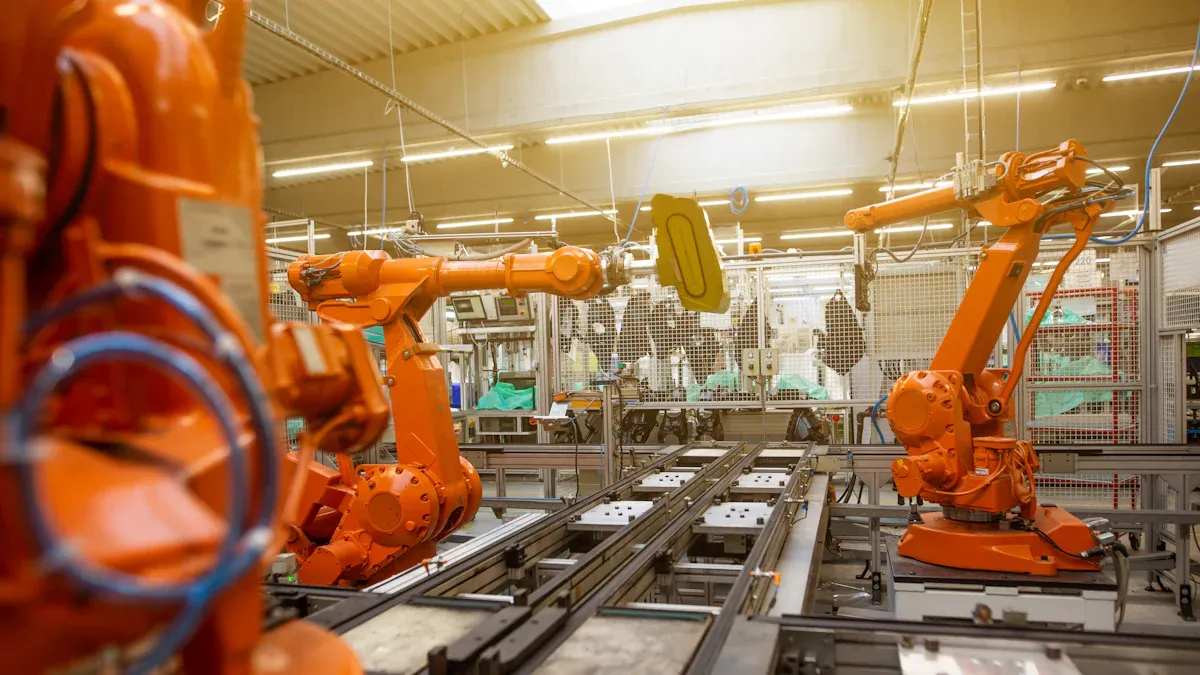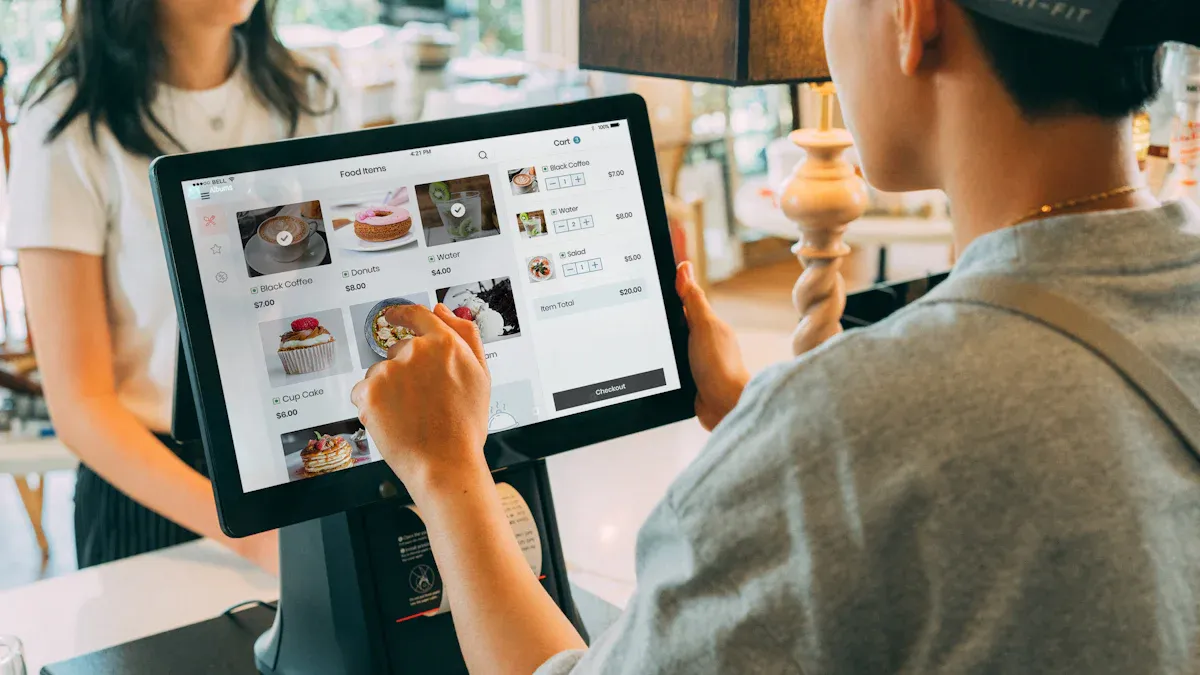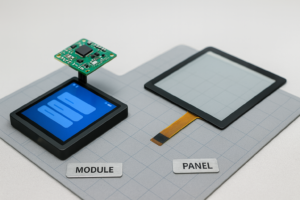Industrial touch screen solutions now drive major improvements in automation. These technologies help operators complete tasks faster and with fewer errors. Touch interfaces simplify complex systems, allowing workers to interact with machines easily. Companies see fewer breakdowns and longer equipment life. Many teams report increased uptime and safer workflows.
Industrial touch screen panels deliver real-world value by streamlining operations and supporting reliable performance.
Key Takeaways
- Industrial touch screens improve automation by making tasks faster, easier, and more accurate for operators.
- Different touch screen types suit various environments, with features like glove support and multi-touch enhancing usability.
- Durable designs protect screens from dust, water, shock, and extreme temperatures, ensuring reliable performance.
- Intuitive interfaces and real-time data help reduce errors, speed training, and boost productivity in factories and warehouses.
- Future trends like multi-touch advances and IoT integration will make touch screens smarter, more connected, and even tougher.
Industrial Touch Screen Technologies

Touch Screen Types
Industrial touch screen technologies use several main types, each with unique strengths. The most common types include resistive, surface capacitive, projected capacitive (PCAP), surface acoustic wave (SAW), and infrared (IR). Operators choose a type based on the needs of their environment and application.
| Touch Technology | Key Advanced Capabilities | Limitations and Considerations |
|---|---|---|
| Resistive | – Works with any object (finger, stylus, glove) – Low cost, energy efficient – Can be sealed for dust/water resistance (IP65) – Negligible EMI interference | – Lower light transmission – Susceptible to scratches and damage – Limited size and multi-touch support – Touch drift over time |
| Surface Capacitive | – Superior image quality – Resistant to grime and dust – Available up to ~32″ – Affordable advanced technology | – Requires bare finger or capacitive stylus – Affected by liquids and damage – No multi-touch support – Calibration tied to controller |
| Projected Capacitive (PCAP) | – Excellent image clarity and brightness – Scratch and impact resistant (with toughened glass) – Works in various weather conditions – True multi-touch support – Can work with gloved hands – Suitable for large displays | – Higher cost – Sensitive to electromagnetic interference – Requires careful integration |
| Surface Acoustic Wave (SAW) | – High scratch resistance and durability – Can operate with gloves or soft-tip stylus – Excellent image clarity (no conductive coatings) | – Not suitable for outdoor use – Affected by water droplets and residue – Cannot use hard objects (pen, fingernail) – Limited to single/dual touch – Prone to dust/liquid ingress |
| Infrared (IR) | – No touch-detecting overlay needed – Uses IR light grid for touch detection – Can be protected by glass/plastic shield | – Sensitive to environmental interference – Frame required around display |
Projected capacitive screens offer true multi-touch support and high durability. Resistive screens work well with gloves and styluses, making them popular in harsh environments. Surface capacitive and SAW screens provide excellent image clarity. Infrared screens detect touch without overlays, which helps in some specialized applications.
Studies by Bhalla & Bhalla (2010) show that choosing the right technology improves operational efficiency and user interaction.
Durability Features
Industrial touch screen panels must withstand tough conditions. Manufacturers design these screens with features that protect against shock, vibration, and extreme temperatures. Many models use toughened glass or steel chassis for extra strength. Optical bonding adds another layer of protection by reducing glare and increasing structural integrity.
| Durability Feature | Specification / Result |
|---|---|
| IP Rating | IP65 (dust tight and water protection against nozzle) |
| Shock Resistance | Withstands prolonged shock and vibration |
| Vibration Resistance | Up to 2.5GRMs and 20Gs |
| Operating Temperature Range | -20°C to +60°C |
| Optical Bonding | Enhances structural integrity and reduces glare |
| Certifications | Class I, Division 2; ATEx; IECEx for hazardous locations |
| Chassis Material | Steel black chassis for durability |
Many industrial touch screen models meet IP65 standards, which means they resist dust and water. Some screens pass tests for shock and vibration, making them suitable for factories and outdoor sites. Optical bonding not only protects the display but also improves visibility in bright environments.
Environmental Resistance
Industrial environments often expose equipment to dust, moisture, chemicals, and temperature swings. Industrial touch screen panels use special sealing and coatings to block out dust and liquids. Some models operate in temperatures from -20°C to +60°C, which covers most industrial settings.
Note: Operators can use many industrial touch screen panels with gloves or styluses. This feature increases safety and efficiency in hazardous or sterile environments.
Electromagnetic interference (EMI) can disrupt sensitive equipment. Many industrial touch screen designs include EMI shielding to prevent signal loss or errors. Some models also achieve IK10 impact ratings, which means they can withstand strong impacts without damage.
Industrial touch screen solutions combine advanced technology, rugged construction, and environmental resistance. These features ensure reliable performance in demanding automation applications.
Benefits for Automation
Productivity Gains
Industrial automation relies on speed and accuracy. Industrial touch screen panels help operators complete tasks faster. Workers can access controls and information with a single tap. This reduces the time spent navigating complex menus or searching for physical buttons. Teams can respond to changes in production lines quickly. As a result, companies see higher output and fewer delays.
Many factories report that touch screens reduce training time for new staff. Operators learn to use the system in hours instead of days. This quick learning curve means less downtime and more consistent performance. Touch screens also support remote monitoring, so supervisors can oversee multiple sites from one location. This flexibility leads to better resource allocation and improved workflow.
Tip: Companies that use touch screens often notice fewer manual errors and faster troubleshooting.
Intuitive Interfaces
Intuitive interfaces make automation systems easier to use. Modern touch screens display clear icons, real-time data, and interactive controls. Operators can see system status at a glance and make adjustments without confusion. This reduces the risk of mistakes and increases confidence on the factory floor.
The following table compares traditional control systems with intuitive interfaces like SCADA:
| Feature/Aspect | Traditional Control Systems | SCADA (Intuitive Interface) |
|---|---|---|
| Scalability and Flexibility | Difficult and costly to scale; major system changes needed | Highly scalable and flexible; easily integrates new devices |
| Data Acquisition | Periodic readings; manual and inconsistent data collection | Continuous real-time monitoring and data acquisition |
| Control Method | Requires on-site operator presence for adjustments | Enables remote control and automation, reducing on-site needs |
| Data Analysis | Manual, time-consuming, limited historical data availability | Stores extensive historical data; supports advanced analytics |
| Alarm Management | Limited prioritization; risk of alarm fatigue and delays | Sophisticated alarm management with prioritization |
| Regulatory Compliance | Manual reporting prone to errors and inconsistencies | Automated, accurate reporting facilitating compliance |
| Operational Efficiency | Lower due to manual tasks and delayed responses | Enhanced by automation, real-time insights, and proactive control |
| Reliability and Availability | Higher risk of failures and downtime due to delayed detection | Improved by early issue detection and predictive maintenance |
| Cost Implications | Higher operational costs due to manual labor and downtime | Cost savings from reduced labor and optimized processes |
| Safety and Security | Limited monitoring and slower emergency response | Real-time monitoring and advanced security features |
| Environmental Compliance | Challenging due to manual data handling | Supports sustainable operations with accurate monitoring |
Touch screens allow operators to interact with automation systems in a way that feels natural. They can zoom, swipe, and tap to access information. This design reduces cognitive load and helps users focus on important tasks. Intuitive interfaces also support multiple languages, making them accessible to diverse teams.
Reliability and Uptime
Reliability is critical in industrial environments. Industrial touch screen panels use rugged materials and advanced technology to ensure continuous operation. Many models resist dust, water, and extreme temperatures. This durability means fewer breakdowns and less maintenance.
Touch screens also improve uptime by supporting predictive maintenance. Systems can alert operators to potential issues before they cause failures. Early detection allows teams to fix problems quickly and avoid costly downtime. Real-time monitoring and automated alarms help maintain safe and efficient operations.
Note: Reliable touch screens keep automation systems running smoothly, even in harsh conditions.
Industrial Touch Screen Applications

Manufacturing Control
Manufacturing environments demand speed, accuracy, and adaptability. Touch screens help operators interact with machines quickly and accurately.
- Operators complete tasks faster with multi-touch gesture support and high-performance processors.
- Intuitive interfaces reduce training time and lower error rates, which improves quality control.
- Robust hardware and remote diagnostics increase system reliability and uptime, leading to fewer production stoppages.
- Flexible screen sizes and scalable systems allow companies to adapt to changing processes and optimize investments.
- Streamlined workflows and real-time data access accelerate decision-making and reduce manual errors.
Production lines now use touch screens for equipment monitoring, control dashboards, and supply chain tracking. These improvements lead to measurable gains in productivity and cost savings.
Process Monitoring
Process monitoring relies on accurate, real-time data. Touch screens provide clear dashboards and easy data entry, even in challenging conditions. The following table shows how touch screens enhance key performance metrics:
| Performance Metric | Enhancement via Touch Screens |
|---|---|
| Production Throughput | Real-time feedback enables quick corrective actions, maintaining or increasing throughput. |
| Quality Results | Accurate recording of measurements, even with gloves or in low light. |
| Process Status | At-a-glance visualization reduces the need to check multiple gauges. |
| Performance Toward Goals | Real-time monitoring of targets supports better decision-making. |
| Data Entry Accuracy | Simplified data entry improves accuracy and breaks language barriers. |
| Accessibility & Usability | Large, bright screens help vision-impaired workers; language options support diverse teams. |
| Environmental Adaptability | Screens work in hazardous or low-light areas, keeping data accessible. |
These features help teams maintain quality and efficiency in complex industrial settings.
Logistics and Warehousing
Warehouses and logistics centers benefit from rugged touch screens. A major logistics company used industrial tablets with barcode scanning to track inventory and manage shipments. This change reduced handling time and improved overall productivity.
- Rugged design withstands drops and harsh environments.
- Barcode scanning speeds up inventory tracking.
- Real-time updates help workers locate items and manage shipments efficiently.
Touch screens in logistics support faster order fulfillment and better inventory control.
Public and Medical Use
Touch screens also improve service and accessibility in public and medical settings.
| Performance Outcome | Description | Context |
|---|---|---|
| High public usage rates | Over 20.8% of people used a single kiosk in a shopping center over 7 months | Public community settings |
| Large scale engagement | 120 kiosks recorded over 306,302 pages viewed in one year | Public community settings |
| Ease of use and accessibility | 99% of users in a cancer clinic found kiosks easy to use, even without computer experience | Medical clinical setting |
| User satisfaction with info | 79% found info easy to use, 90% easy to find, 88% easy to understand | Hospital setting |
| Demographic inclusivity | Kiosks worked well for all ages, genders, and education levels | Public and medical settings |
| Privacy perception | 12-inch screens felt more private; privacy partitions improved perception | Medical setting |
| Elimination of keyboard skills | Touch input helped low literacy and non-English speakers use kiosks easily | Medical setting |
| Comparative effectiveness | Kiosks outperformed paper and PDA for pre-admission questionnaires | Medical education delivery |
| Design for reliability | Features like modular data entry and error checking improved reliability | Medical emergency department |
Touch screens make information and services more accessible, reliable, and user-friendly for everyone.
Choosing an Industrial Touch Screen
Environment Assessment
Selecting the right industrial touch screen starts with a careful assessment of the operating environment. Teams should consider factors such as temperature extremes, exposure to dust or water, and the risk of physical impacts. High IP ratings, like IP65 or above, ensure waterproof and dustproof performance. Shock and vibration resistance are essential for industries like mining or automotive. Screen size and brightness also matter. Large, high-brightness screens improve visibility in outdoor or poorly lit areas.
Tip: Always match the device’s durability features to the harshest conditions expected in the workspace.
Technology Selection
Choosing the correct technology type depends on the tasks and user needs. The table below compares common touchscreen technologies:
| Touchscreen Technology | Input Compatibility | Sensitivity & Accuracy | Durability & Suitability | Environmental Considerations |
|---|---|---|---|---|
| Resistive | Finger, gloves, stylus | Moderate sensitivity | Durable, good for gloves | Dusty, rough conditions |
| Capacitive | Bare skin, special gloves | High responsiveness, multi-touch | Less durable, clear display | Precise, modern tasks |
| Infrared (IR) | Any solid object | Moderate accuracy | Less durable in dust | Controlled or outdoor use |
| Surface Acoustic Wave | Finger, soft stylus | High clarity, accuracy | Not for dust/wet areas | Precision over ruggedness |
Studies show that touch panels often outperform traditional input devices for manual selection and multi-touch tasks. Ergonomic design and responsiveness play a key role in usability. Teams should match technology to the specific interaction needs and tasks in their facility.
Customization Options
Many manufacturers offer customization to fit unique requirements. Options include screen size, mounting style, brightness, and anti-glare coatings. Some panels support glove or stylus input for safety or hygiene. Custom enclosures can add extra protection or meet branding needs. Integration with existing systems and software ensures seamless operation.
Vendor and Support
Reliable vendor support is crucial for long-term success. Top vendors achieve high first-time fix rates and fast parts delivery. For example, some companies maintain a 96% first-time fix rate and deliver 89% of parts on time. Service leaders use advanced tools, such as custom service apps and real-time support devices, to resolve issues quickly. Global logistics centers and premium repair options help minimize downtime. Proactive service contracts and clear performance goals further improve reliability.
Note: Strong vendor support reduces downtime and ensures the industrial touch screen continues to perform in demanding environments.
Future Trends
Multi-Touch Advances
Multi-touch technology continues to evolve rapidly. Manufacturers now use advanced sensors, AI-driven gesture recognition, and haptic feedback to create more responsive and intuitive interfaces. Flexible and transparent materials enable foldable screens and energy-efficient designs. These innovations help operators interact with machines using multiple fingers or gestures, making complex tasks easier and faster.
The market for multi-touch digital devices is growing at a compound annual growth rate (CAGR) of 13.5% from 2025 to 2030. Market size is projected to rise from USD 16.753 billion in 2025 to USD 31.549 billion by 2030. Industrial automation remains a key driver, especially in the Asia-Pacific region, where smartphone adoption and automation investments are highest.
| Aspect | Details |
|---|---|
| Market CAGR | 13.5% (2025–2030) |
| Market Size Projection | USD 16.753B (2025) → USD 31.549B (2030) |
| Key Innovations | AI gesture recognition, haptic feedback, flexible materials, energy efficiency |
| Fastest-Growing Region | Asia-Pacific |
IoT Integration
IoT integration shapes the future of industrial automation. Touch screens now connect with sensors, machines, and cloud platforms to enable real-time data exchange. Industry research reports highlight Industry 4.0 and smart manufacturing as major trends. These trends focus on interconnectivity, automation, and instant data sharing.
- The global industrial touchscreen display market expects a CAGR of 9.03% from 2025 to 2033.
- Market size will likely grow from USD 5.45 billion in 2024 to USD 11.87 billion by 2033.
- Enhanced connectivity options, such as Wi-Fi, Ethernet, and 5G, support real-time processing and IoT expansion.
- Edge computing in touch screens allows faster decision-making and predictive maintenance.
Touch screens with IoT capabilities help factories monitor equipment, predict failures, and optimize workflows.
Enhanced Resistance
Future touch screens must withstand even harsher environments. Manufacturers use optical bonding to fill air gaps with resin, which increases durability and shock resistance. This process also reduces glare and reflections, improving visibility in bright or outdoor settings. Operators benefit from clear screens that resist condensation and fogging, even with temperature or humidity changes.
- Optical bonding improves contrast and image quality, making displays brighter and easier to read.
- Advanced capacitive technologies show significant gains in signal-to-noise ratio, which boosts touch accuracy and noise resistance.
- Case studies show that durable touch screens in medical and industrial settings lead to faster, more accurate data input and better reliability.
These improvements ensure that future touch screens will remain reliable and effective, even as industrial environments become more demanding.
Industrial automation now relies on advanced touch screen technologies to boost productivity, accuracy, and safety. Operators benefit from intuitive controls, real-time monitoring, and durable designs that withstand harsh environments.
The market for touch screens continues to grow, with projections showing strong adoption and rising productivity:
| Metric | Projection / Value | Timeframe |
|---|---|---|
| Global touch screen market size | $61.0B (2022) → $93.9B (2027) | 2022 to 2027 |
| Industrial touch screen CAGR | 10.3% | 2023 to 2030 |
| Manufacturer adoption rate | 45% now, 65% by 2025 | By 2025 |
Manufacturers should explore these solutions to meet future automation needs as trends like AI, IoT, and enhanced durability continue to shape the industry.
FAQ
What makes industrial touch screens different from consumer models?
Industrial touch screens use rugged materials and advanced sealing. They resist dust, water, and impacts. Manufacturers design them for harsh environments. Consumer models focus on aesthetics and light use.
Can operators use industrial touch screens with gloves?
Yes, many industrial touch screens support glove operation. Projected capacitive and resistive technologies allow users to interact while wearing gloves. This feature improves safety and hygiene in industrial and medical settings.
How do companies maintain touch screen reliability in extreme conditions?
Manufacturers use features like optical bonding, EMI shielding, and high IP ratings. These features protect screens from shock, vibration, and temperature changes. Regular maintenance and vendor support also help ensure long-term reliability.
Are industrial touch screens easy to integrate with existing systems?
Most industrial touch screens offer standard connectivity options, such as USB, HDMI, and Ethernet. Many models support common operating systems. Integration with SCADA, PLCs, and IoT platforms is straightforward for most automation teams.
.png)



